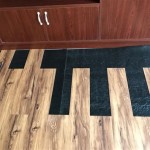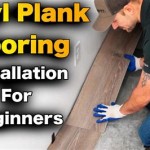Can You Use A Steam Mop On Laminate Wood Flooring?
Laminate wood flooring offers an attractive, durable, and often more affordable alternative to solid hardwood. Its layered construction, typically consisting of a core of high-density fiberboard (HDF) or medium-density fiberboard (MDF) topped with a photographic applique layer and a protective wear layer, makes it resistant to scratches, dents, and fading. This durability contributes to its popularity in both residential and commercial settings. However, proper cleaning and maintenance are crucial to preserving its appearance and lifespan. A frequent question arises regarding the use of steam mops on laminate flooring. The answer is nuanced and depends greatly on several factors, demanding careful consideration to avoid damage.
The allure of steam mops lies in their ability to sanitize surfaces using only heat and water. They eliminate the need for harsh chemicals, making them an environmentally conscious and potentially healthier option for cleaning. Steam's high temperature is effective at killing bacteria, viruses, and other microorganisms, leaving surfaces clean and hygienic. This appeal, however, needs careful assessment regarding its compatibility with laminate flooring's specific qualities.
The primary concern with using steam on laminate flooring stems from the potential for moisture penetration. While the surface wear layer is designed to be water-resistant, the seams between planks and any imperfections in the wear layer can allow moisture to seep into the core. The HDF or MDF core is highly susceptible to water damage, causing it to swell, warp, and delaminate. This damage is often irreversible and can significantly compromise the integrity and appearance of the floor.
Therefore, determining whether a steam mop can be safely used on laminate flooring necessitates a thorough understanding of the risks involved and the mitigating measures that can be taken. Careful consideration of the floor's construction, the steam mop's settings, and the cleaning technique employed are essential to avoid potential damage.
Understanding the Risk: How Steam Affects Laminate
The fundamental challenge with steam mops and laminate flooring is the inherent vulnerability of the core material to moisture. Laminate flooring, unlike solid hardwood, is not a solid piece of wood. It comprises multiple layers, primarily a core made of high-density fiberboard (HDF) or medium-density fiberboard (MDF). These engineered wood products are composed of wood fibers compressed together with resin binders. While strong and durable under normal conditions, they are highly absorbent and prone to swelling when exposed to excessive moisture.
When a steam mop is used, hot steam is directed onto the floor surface. While a quality laminate floor should have a water-resistant wear layer, this layer is not entirely waterproof. Over time, wear and tear, scratches, or imperfections in the seams between planks can compromise its integrity. This allows steam to potentially penetrate through these weak points and reach the core material. The high temperature of the steam further accelerates this process, as heat can cause the seams to expand slightly, creating even more pathways for moisture to enter.
Once moisture penetrates the core, the HDF or MDF begins to absorb it, causing the fibers to swell. This swelling can lead to warping, buckling, and delamination of the flooring. Delamination refers to the separation of the laminate's layers, resulting in a visibly damaged surface. This damage is often irreversible and can require costly repairs or even complete replacement of the flooring.
Even if the laminate flooring is relatively new and in good condition, repeated exposure to steam can gradually weaken the protective wear layer and the seams between planks. This cumulative effect can eventually lead to moisture penetration and subsequent damage. The risk is particularly high in areas with frequent spills or high humidity levels, where the flooring is already more susceptible to moisture exposure.
Therefore, the potential for moisture damage is the primary concern when considering the use of a steam mop on laminate flooring. A cautious approach is essential to minimize this risk and preserve the integrity of the floor.
Factors to Consider Before Using a Steam Mop
Before using a steam mop on laminate floors, several factors should be carefully considered to minimize the risk of damage. Assessing these factors will help determine whether steam cleaning is a suitable option and, if so, what precautions should be taken.
Laminate Quality and Construction: The quality and construction of the laminate flooring play a crucial role in its resistance to moisture. Higher-quality laminates typically have a thicker and more durable wear layer, providing better protection against water penetration. They may also have tighter seams between planks, reducing the risk of moisture seeping through. Check the manufacturer's specifications for the flooring to determine its water resistance rating. If the flooring is an older, less expensive laminate, it may be more susceptible to damage from steam cleaning.
Sealed Seams and Installation: The quality of the floor's installation is equally important. Properly sealed seams between planks prevent moisture from penetrating the core. If the flooring was poorly installed, with gaps or uneven seams, it is more vulnerable to water damage. Inspect the flooring carefully for any signs of damage, such as cracks, chips, or loose seams. Addressing these issues before steam cleaning can help prevent further damage.
Steam Mop Settings: Most steam mops offer adjustable steam settings. Using the lowest steam setting is crucial when cleaning laminate flooring. High steam settings generate excessive moisture, increasing the risk of penetration. The goal is to use just enough steam to clean the surface without saturating it. A dry steam is preferable, where the steam is quickly evaporated leaving the floor almost dry to the touch.
Manufacturer Recommendations: Always consult the laminate flooring manufacturer's instructions regarding cleaning methods. Some manufacturers explicitly prohibit the use of steam mops, while others may allow it under specific conditions. Adhering to the manufacturer's recommendations is essential to avoid voiding the warranty and to ensure the longevity of the flooring.
Previous Damage: If the laminate flooring has existing damage, such as scratches, chips, or warped planks, steam cleaning is generally not recommended. These imperfections can act as entry points for moisture, exacerbating the existing damage and potentially leading to further problems. It is better to address the existing damage before considering any type of wet cleaning.
Testing in an Inconspicuous Area: Before cleaning the entire floor with a steam mop, test it in an inconspicuous area, such as under a piece of furniture or in a closet. This allows you to assess the floor's reaction to the steam without risking visible damage to the main areas. Check the test area for any signs of swelling, warping, or discoloration after a few hours. If any of these issues occur, it is best to avoid using a steam mop on the entire floor.
By carefully considering these factors, you can make an informed decision about whether steam cleaning is a suitable option for your laminate flooring and take necessary precautions to minimize the risk of damage.
Safer Alternatives for Cleaning Laminate Flooring
Given the potential risks associated with using steam mops on laminate flooring, several safer alternatives can effectively clean and maintain its appearance without causing damage. These methods prioritize minimizing moisture exposure and using gentle cleaning agents.
Dry Dusting or Sweeping: Regular dry dusting or sweeping is essential for removing loose dirt, dust, and debris. This prevents these particles from scratching the floor's surface and accumulating in the seams. Use a soft-bristled broom or a microfiber dust mop to effectively collect dust and dirt without damaging the finish.
Damp Mopping with Approved Cleaners: Damp mopping is a safe and effective way to clean laminate flooring, provided you use the right tools and cleaning solutions. Use a microfiber mop and a laminate-specific floor cleaner or a mixture of mild dish soap and water. Ensure the mop is only slightly damp, not soaking wet, to prevent water from seeping into the seams. Wring out the mop thoroughly before each pass and avoid leaving standing water on the floor.
Using a Spray Mop: Spray mops are designed to dispense a measured amount of cleaning solution directly onto the floor, minimizing the amount of moisture used. Fill the spray mop's reservoir with a laminate-specific cleaner or a diluted mixture of mild soap and water. Spray the floor lightly and mop immediately with the attached microfiber pad. Avoid over-spraying and ensure the floor dries quickly.
Spot Cleaning Spills Immediately: Addressing spills promptly is crucial to prevent them from soaking into the floor and causing damage. Use a clean, dry cloth to blot up spills immediately. Avoid rubbing, as this can spread the spill and potentially damage the finish. For sticky spills, dampen a clean cloth with warm water and gently wipe the affected area.
Using Doormats and Rugs: Placing doormats at entrances and rugs in high-traffic areas can help protect laminate flooring from dirt, scratches, and moisture. These mats and rugs trap dirt and debris before they can be tracked onto the floor, reducing the need for frequent cleaning. Choose mats and rugs with non-slip backings to prevent them from sliding and potentially scratching the floor.
Vacuuming with a Soft Brush Attachment: Vacuuming can effectively remove dirt and debris from laminate flooring, but it's important to use a vacuum with a soft brush attachment to avoid scratching the surface. Avoid using vacuums with beater bars, as they can damage the finish. Ensure the vacuum is set to the appropriate height for hard floors to prevent scratching.
Avoiding Harsh Chemicals and Abrasive Cleaners: Never use harsh chemicals, abrasive cleaners, or scouring pads on laminate flooring. These products can damage the wear layer and dull the finish. Stick to laminate-specific cleaners or mild, pH-neutral solutions.
By adopting these safer cleaning practices, you can maintain the beauty and longevity of your laminate flooring without risking moisture damage or other issues associated with steam cleaning. Regular maintenance and prompt attention to spills will help keep your floors looking their best for years to come.

Can You Damage Your Floor With A Steam Mop

Can You Damage Your Floor With A Steam Mop

Can You Use A Steam Mop On Laminate Floors The Queen

Can You Use A Steam Mop On Hardwood Risky Flooring Tips Reallyfloors America S Est

How To Clean Laminate Flooring Factory Direct

Steam Cleaning Wood Floors More Like Scalding Them Rosebud

Steam Cleaning Wood Floors More Like Scalding Them Rosebud

How To Clean Laminate Floors The Home Depot

Do Steam Mops Really Work

Boiling Water And Steam Mops Can Cause Serious Damage For Wood Vinyl Laminate Express Co
Related Posts








